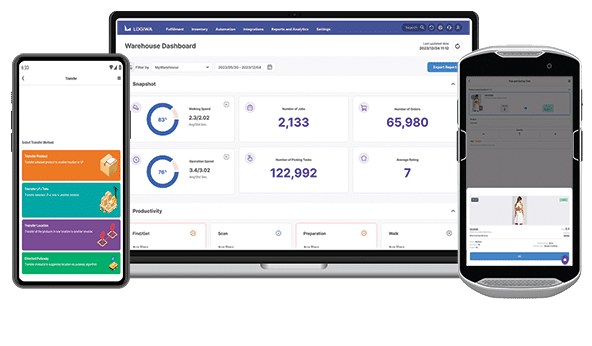Who knew operating a warehouse would require learning so many acronyms? From WMS to ERP to WES, it can be challenging to figure out which systems and warehouse logistics software you need for successful warehouse management.
We often get asked the difference between WES vs. WMS tools. Do you need both? Can they work together? Which one do you need if you’re running a smaller operation? In this guide, we’ll answer all of these questions and more.
Keep reading to learn more about WMS, warehouse logistics software, WES and which one is right for you.
In this guide, we’ll explore:
WES vs. WMS: What Are They?
You may hear the term warehouse logistics software thrown around, and it’s often used interchangeably with WMS or WES. While both warehouse management software (WMS) and warehouse execution software (WES) can be considered types of warehouse logistics software, there are some subtle differences between the two.
The simplest way to describe the difference between WES and WMS is like this:
Warehouse execution systems direct the processes inside your warehouse to ensure products move in the most efficient way possible. Warehouse management systems control inventory flow into, within, and out of your warehouse or distribution center.
Warehouse logistics and operations are the most important part of warehouse management. Understanding all the moving parts is crucial. Let’s dig a little deeper to explore the differences between WES vs. WMS.
What Is a Warehouse Execution System (WES)?
Warehouse execution systems can essentially be described as “WMS lite,” with functionality to direct processes within your warehouse.
Once inventory is inside your warehouse, a WES can take over, working in real-time to organize, sequence, and synchronize your warehouse resources. This includes everything from your people to the equipment used to get your inventory back out the door.
What Is a Warehouse Management System (WMS)?
Warehouse management system software consolidates multiple management processes into one solution and keeps inventory moving through a warehouse as efficiently and cost-effectively as possible.
A WMS provides practical inventory management to optimize the actions within a given workflow. If it impacts your warehouse or fulfillment center operation, a WMS will have a record of it. That includes inbound and outbound processes.

WES vs. WMS: A Feature Comparison
When it comes to WES and WMS solutions, both ultimately improve warehouse processes and optimize the efficiency of fulfillment operations. But like most technologies, there are distinct differences that set them apart, primarily the scope of their fulfillment functions. Let’s dig into the differences between WES and WMS solutions, so you can determine which makes the most sense for your enterprise.
Key Features of a WES
As mentioned above, a WES can direct all the processes inside your warehouse. It can manage all of your warehouse resources, including material handling equipment, devices such as scanners, and employees with real-time functionality.
A warehouse execution system is reactive. It ensures orders move through your warehouse in a continuous flow based on the completion of a previous step.
For small and medium-sized operations, a WES might be the ideal choice for you as it can help manage fulfillment for both consumers and stores. But once your retail chain grows, you’ll likely need a more advanced inventory management system.
A WES can help with several tasks, including:
- Basic receiving
- Shipping management
- Replenishment management
- Inventory management
- Automated picking management
However, a WES can’t help with some tasks such as:
- Supply chain integration
- Transportation management
- Reverse putaway
- Order management
Key Features of a WMS
A warehouse management system manages all inbound and outbound warehouse processes and everything in between, including:
- Order fulfillment from the time inventory arrives at your loading dock
- Moving items to the shelves and through the picking and packing process
- Shipping and invoicing
- Optimizing all processes in your warehouse to reduce costs
- Improving employee efficiency
- Keeping your clients and customers happy
Many warehouse management systems can integrate with popular ecommerce, shipping, and accounting partners to further simplify your processes.
There are several critical features of a WMS such as:
- Location management
- Item management
- Receiving
- Returns
- Picking and packing
- Billing
- Order routing
- Inventory count operations
- Walking path optimizations
How Do I Choose a Warehouse Logistics Software System?
Now that we know the key differences between a WES vs. WMS, which one is better for your business?
If you’re a smaller operation, you may not need to invest in a WMS quite yet and can start with a WES until you’re ready to grow your business. However, if you’re a larger operation, a WMS will provide the robust tools you need for warehouse success.
It’s important to note that a WES will not replace a WMS. Integrating a WES into your WMS will make the latter function even better by ensuring that your equipment and personnel are fully optimized to meet the needs of all your warehouse processes, from inbound to outbound.
WES vs. WMS FAQs
What Is Warehouse Logistics Software?
Warehouse logistics software is software that helps run the day-to-day operations of a warehouse. It makes processes and systems easier to follow and may be used interchangeably with the term “warehouse management system” or WMS when describing the software that manages a warehouse.
What Is a WES?
Warehouse execution systems can direct the processes inside your warehouse to ensure your products get in and out the door efficiently. They can be used in tandem with WMS systems.
What Is a WMS?
Warehouse management systems consolidate multiple management processes into one solution and keep inventory moving through a warehouse. These systems improve the processes that simplify operations for staff and help to eliminate human error.
What Are the Key Features of a WES?
A warehouse execution system can direct all the processes that take place inside your warehouse. It can communicate with inventory and order management systems as well as personnel and machinery. As a result, it simplifies basic tasks such as receiving, shipping, inventory management, replenishment management, and automated picking management.
What Are the Key Features of a WMS?
There are many key features of a WMS. Some include location and item management, receiving and returns, picking and packing, order routing, billing, and walking path optimization. Many warehouse management systems can integrate with popular ecommerce, shipping, and accounting partners.
What Is a Warehouse Control System (WCS)?
A warehouse control system (WCS) is another type of system that helps direct internal warehouse processes related to material handling and product flow, and keeps inventory items moving throughout a fulfillment center for optimum efficiency. This includes the transportation of items to conveyor belts, carousels, put-to-light systems, scales, AS/RS systems, AGVs, and similar systems to maximize throughput.





